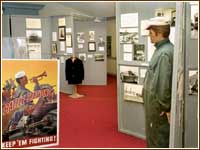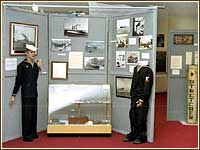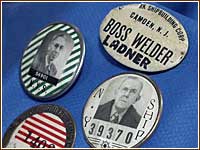CAMDEN'S GOLDEN ERA OF SHIPBUILDING
Exhibit Details Life at New York Ship Yard During World War II
By Hoag Levins
 | |
 March 1, 2001
March 1, 2001
CAMDEN, N.J. -- In the largest display ever mounted on the subject, the Camden County Historical Society has launched an exhibit celebrating the region's massive role in the shipbuilding efforts that helped win World War II.

Photo: CCHS Archives
|
| Looming above the Delaware River shoreline like a cliff of steel, the USS Saratoga (CV-3) is shown under construction at the New York Shipbuilding Corp in Camden, N.J. The U.S. Navy vessel went on to take part in some of the most important Pacific battles of World War II. Larger photo.
| Currently open to the public at the Pomona Hall library and museum complex, "In Harms Way: New York Shipbuilding in WW II" offers a comprehensive look at life in Camden's New York Shipbuilding Corp. during the war.
The walk-through exhibit consists of hundreds of artifacts and images from the Society's New York Shipbuilding holdings -- the region's largest such collection of its kind. Many of the show's displays are hung on battleship gray pegboard gallery structures -- the same materials that were commonly used in the 1940s at the yard.
Tens of thousands of people throughout the area have strong ties to New York Ship, as it was called. It was so large and touched the lives of so many that Camden County is a different place because of it. Entire towns were established just to house the huge population of workers needed to run the sprawling waterfront facility. And the yard's output of craft during World War II helped change the course of the war at the same time is drove the economy of the whole region. It also turned Camden into a thriving "Navy town" that hosted and housed large numbers of sailors throughout the war.
Curiously misnamed
Curiously misnamed, the New York Ship Corporation -- which never had operations in New York -- sprawled along

Photo: CCHS Archives
|
| New York Ship Corp.'s covered ways were a Delaware River landmark. Shown here is the 1929 launch of the cruiser USS Salt Lake City. Larger photo.
| a two-mile curve of the Delaware River in Camden. During the 1940s, it was the world's largest private shipbuilding facility; a thriving city within a city that employed more than 35,000 people.
Originally established in 1899, New York Ship went out of business in 1967, leaving behind a legacy of maritime accomplishment that today surprises many who are unaware that Camden was once a world-class shipbuilding power.
Maritime engineering pioneer
The company was started by industrial magnate Henry G. Morse, backed by financial barons Andrew Mellon and Henry Frick. Morse pioneered the concept of a shipbuilding yard organized around the same mass production techniques -- on a gigantic scale -- used by earlier industrial visionaries to manufacture mechanical items like watches, rifles, and railroad locomotives.
The enormous metal ship sections were prefabricated from templates in closed shops and then

Photo: Hoag Levins
|
| The Historical Society has the region's largest collection of New York Ship artifacts and many are on display in the exhibit. Larger photo.
| transported to, and assembled in, twelve-story-high, covered ship ways. The covered ways allowed assembly to continue regardless of the weather. A chain of massive cranes served as a conveyor belt system across 180 acres of factory complex. The unique ship ways were a landmark in the history of maritime engineering as well the geography of Camden County.
By the late 1930s, as war exploded across Europe and tensions increased between the U.S. and Japan, New York Ship had become one of the pre-eminent centers for the construction of battleships, aircraft carriers, seaplane tenders, battle cruisers, patrol boats, destroyers and specialized military landing craft. During the global conflict, the ships of Camden played crucial roles in naval battles ranging from the invasions of northern Africa and Normandy to the liberation of Philippines and conquest Iwo Jima.
Dirty, demanding, dangerous
Driven by a sense of patriotic zeal as well as steady salaries, tens of thousands of Camden

Photo: Hoag Levins
|
| The shipyard made Camden a WWII "Navy town" with large numbers of sailors passing through or living nearby on a regular basis.
Larger photo.
| County residents toiled round-the-clock in the yard constructing those craft. The work was frenzied, dirty, demanding and dangerous. And it was performed by a tight-knit community that kept its eyes and ears ever cocked to events around the world; that kept a constant watch for which vessels had been sunk or crippled, what battles had been won or lost, and which relatives or friends had died or been wounded on distant battlefields that week.
For most yard employees, the war years constituted the most harrowing, exciting and memorable period of their lives -- an event that gave each life a larger meaning.
"In Harm's Way" was designed to recreate the essence of that experience with a mix of museum artifact displays, videos, oral histories, documents and a collection of rare photos that provides a comprehensive and compelling view of the gritty, clanging reality that was the shipyard in full-capacity war-time operation.
Air raid badges
Displays include daily personal logs kept by workers, local newspaper accounts of yard events,

Photo: Hoag Levins
|
| New York Ship workers were prepared for Japanese or German bombing attacks on Camden. Larger photo.
| propaganda posters, signs from the yard, and items like employee badges, including the "Air Raid" badges that authorized workers to enter shelters in the event of a German or Japanese bombing attack on Camden.
Until recent years, there was surprisingly little published on the history of New York Shipbuilding and as the wartime generation dies off, it takes its collective memories with it. That's why the Historical Society has been recording interviews with former shipyard workers. Fifty such audio recordings have been made so far and more are planned.
A dying generation
The organization feels a need to continue its oral history project before the rest of the subjects pass away.

Photo: Hoag Levins
|
| Tens of thousands of Camden County-area residents were part of every facet of New York Ship's giant operations. Their badges are part of a collection that tells a story of the professionalism, dedication and 'can-do ethic' that helped enable the United States to win the war. Larger photo.
|
Perhaps the most poignant artifacts are the black and white photos that portray the interviewees -- now in their 70s, 80s and 90s -- as they looked when they worked at the yard in their teens and 20s. It helps to bring the scene back to life in a way that has brought tears to the eyes of many of the former yard workers.
"In Harms Way" is open to the public at the Camden County Historical Society's headquarters located behind Our Lady of Lourdes Medical Center at Park Boulevard and Euclid Avenue in Camden.
All Rights Reserved © 2001 - 2009, Hoag Levins
HoagL@earthlink.net
About this Web site
| 








